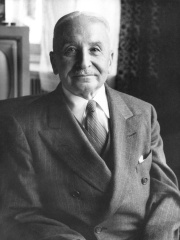
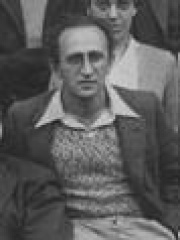
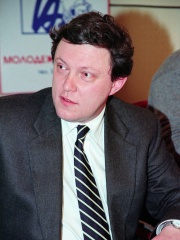

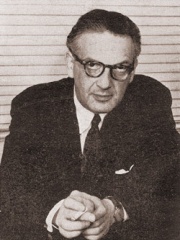
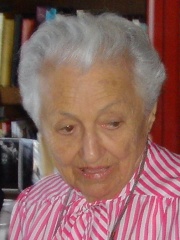
The Most Famous
ECONOMISTS from Ukraine
This page contains a list of the greatest Ukrainian Economists. The pantheon dataset contains 414 Economists, 7 of which were born in Ukraine. This makes Ukraine the birth place of the 12th most number of Economists behind Austria, and Türkiye.
Top 7
The following people are considered by Pantheon to be the most legendary Ukrainian Economists of all time. This list of famous Ukrainian Economists is sorted by HPI (Historical Popularity Index), a metric that aggregates information on a biography's online popularity.

1. Ludwig von Mises (1881 - 1973)
With an HPI of 74.80, Ludwig von Mises is the most famous Ukrainian Economist. His biography has been translated into 61 different languages on wikipedia.
Ludwig Heinrich Edler von Mises (; German: [ˈluːtvɪç fɔn ˈmiːzəs]; September 29, 1881 – October 10, 1973) was an Austrian and American political economist and philosopher of the Austrian school. Mises wrote and lectured extensively on the social contributions of classical liberalism and the central role of consumers in a market economy. He is best known for his work in praxeology, particularly for studies comparing communism and capitalism, as well as for being a defender of classical liberalism in the face of rising illiberalism and authoritarianism throughout much of Europe during the 20th century. In 1934, Mises fled from Austria to Switzerland to escape the Nazis and he emigrated from there to the United States in 1940. On the day German forces entered Vienna, they raided his apartment, confiscating his papers and library, which were believed lost or destroyed until rediscovered decades later in Soviet archives. At the time, Mises was living in Geneva, Switzerland. However, with the imminent Nazi occupation of France threatening to isolate Switzerland within Axis-controlled territory, he and his wife fled through France—avoiding German patrols—and reached the United States via Spain and Portugal. Since the mid-20th century, both libertarian and classical liberal movements, as well as the field of economics as a whole have been strongly influenced by Mises's writings. Economist Tyler Cowen lists his writings as "the most important works of the 20th century" and as "among the most important economics articles, ever". Entire schools of thought trace their origins to Mises's early work, including the development of anarcho-capitalist philosophy through Murray Rothbard and the contemporary Austrian economics program led by scholars such as Peter Boettke at George Mason University. Mises's most influential work, Human Action: A Treatise on Economics (1949), laid out his comprehensive theory of praxeology—a deductive, a priori method for understanding human decision-making and economic behavior. Rejecting empirical and mathematical modeling, Mises defended classical liberalism and market coordination as products of rational individual action. Beyond his published works, Mises shaped generations of economists through his longstanding private seminar in Vienna and later as a professor at New York University. His ideas deeply influenced students such as Friedrich Hayek, Murray Rothbard, and Israel Kirzner, who helped inspire the rise of postwar libertarian institutions in the United States, including the Foundation for Economic Education and the Ludwig von Mises Institute. Mises received many honors throughout the course of his lifetime—honorary doctorates from Grove City College (1957), New York University (1963), and the University of Freiburg (1964) in Germany. His accomplishments were recognized in 1956 by his alma mater, the University of Vienna, when his doctorate was memorialized on its 50th anniversary and "renewed", a European tradition, and in 1962 by the Austrian government. He was also cited in 1969 as "Distinguished Fellow" by the American Economic Association.

2. Abba P. Lerner (1903 - 1982)
With an HPI of 60.90, Abba P. Lerner is the 2nd most famous Ukrainian Economist. His biography has been translated into 23 different languages.
Abraham "Abba" Ptachya Lerner (also Abba Psachia Lerner; 28 October 1903 – 27 October 1982) was a Russian-born American-British economist.

3. Grigory Yavlinsky (b. 1952)
With an HPI of 59.39, Grigory Yavlinsky is the 3rd most famous Ukrainian Economist. His biography has been translated into 27 different languages.
Grigory Alekseyevich Yavlinsky (Russian: Григо́рий Алексе́евич Явли́нский, romanized: Grigóriy Aleksyéyevich Yavlínskiy; born 10 April 1952) is a Russian economist and politician. He has held numerous positions in the Soviet and Russian governments across different levels, including in the State Duma. Yavlinsky was one of authors of the 500 Days Program, a plan for the transition of the Soviet regime to a free-market economy, and is the former leader of the opposition Yabloko party. He has run three times for Russia's presidency. In 1996 he ran against Boris Yeltsin, finishing fourth with 7.3% of the vote. In 2000 Yavlinsky ran against Vladimir Putin, finishing third with 5.8%. In the 2012 presidential election he was prevented from running for president by Russian authorities, despite collecting the necessary 2 million signatures of Russian citizens for his candidacy. Yavlinsky was Yabloko's candidate for Russian President in the 2018 presidential election, when he ran against Putin and got 1.05% of the vote, according to the results. Many of the election results were not recognised by his party due to corroborated allegations of irregularities. Yavlinsky holds a PhD in economics from the Central Economic Mathematical Institute of the Russian Academy of Sciences; his doctoral dissertation was entitled "The socio-economic system of Russia and the problem of its modernisation". He is a professor at the National Research University Higher School of Economics.

4. Alexander Gerschenkron (1904 - 1978)
With an HPI of 57.44, Alexander Gerschenkron is the 4th most famous Ukrainian Economist. His biography has been translated into 16 different languages.
Alexander Gerschenkron (Russian: Александр Гершенкрон; 1 October 1904 – 26 October 1978) was an American economic historian and professor at Harvard University, trained in the German Historical School of economics. Born into a Jewish family in Odessa, then part of the Russian Empire, now in Ukraine, Gerschenkron fled the country during the Russian Civil War in 1920 to Austria, where he attended the University of Vienna, earning a doctorate in 1928. After the Anschluss in 1938, he emigrated to the United States.
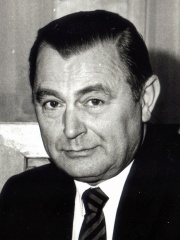
5. Zbigniew Messner (1929 - 2014)
With an HPI of 56.45, Zbigniew Messner is the 5th most famous Ukrainian Economist. His biography has been translated into 22 different languages.
Zbigniew Stefan Messner (Polish: [ˈzbiɡɲɛf ˈmɛsnɛr] ; 13 March 1929 – 10 January 2014) was a Polish communist politician and economist. His ancestors were of German Polish descent who had assimilated into Polish society. In 1972, he became Professor of Karol Adamiecki University of Economics in Katowice. In the 1980s, Messner held numerous high ranking posts within communist party apparatus. He was a member of the Central Committee of the Polish United Workers' Party (PZPR) from 1981 to 1990, when PZPR was dissolved, member of the PZPR Politburo from 1981 to 1988, Deputy Prime Minister from 1983 to 1985, member of Sejm from 1985 to 1989, Prime Minister of Polish People's Republic from 1985 to 1988 and member of the State Council of the Polish People's Republic from 1988 to 1989. Additionally in the 1960s Messner was the chairman of Piast Gliwice football club.

6. Paul A. Baran (1909 - 1964)
With an HPI of 54.41, Paul A. Baran is the 6th most famous Ukrainian Economist. His biography has been translated into 17 different languages.
Paul Alexander Baran (; 30 August 1909 – 26 March 1964) was an American Marxist economist. In 1951, Baran was promoted to full professor at Stanford University. He was the only tenured Marxian economist in the United States until his death in 1964 . He wrote The Political Economy of Growth in 1957 and co-authored Monopoly Capital with Paul Sweezy.

7. Rose Friedman (1910 - 2009)
With an HPI of 52.16, Rose Friedman is the 7th most famous Ukrainian Economist. Her biography has been translated into 16 different languages.
Rose Director Friedman ; born Rose Director (30 December 1910 – 18 August 2009) was a free-market economist and co-founder of the Milton and Rose D. Friedman Foundation.
People
Pantheon has 7 people classified as Ukrainian economists born between 1881 and 1952. Of these 7, 1 (14.29%) of them are still alive today. The most famous living Ukrainian economists include Grigory Yavlinsky. The most famous deceased Ukrainian economists include Ludwig von Mises, Abba P. Lerner, and Alexander Gerschenkron.
Living Ukrainian Economists
Go to all RankingsDeceased Ukrainian Economists
Go to all RankingsLudwig von Mises
1881 - 1973
HPI: 74.80
Abba P. Lerner
1903 - 1982
HPI: 60.90
Alexander Gerschenkron
1904 - 1978
HPI: 57.44
Zbigniew Messner
1929 - 2014
HPI: 56.45
Paul A. Baran
1909 - 1964
HPI: 54.41
Rose Friedman
1910 - 2009
HPI: 52.16
Overlapping Lives
Which Economists were alive at the same time? This visualization shows the lifespans of the 6 most globally memorable Economists since 1700.

